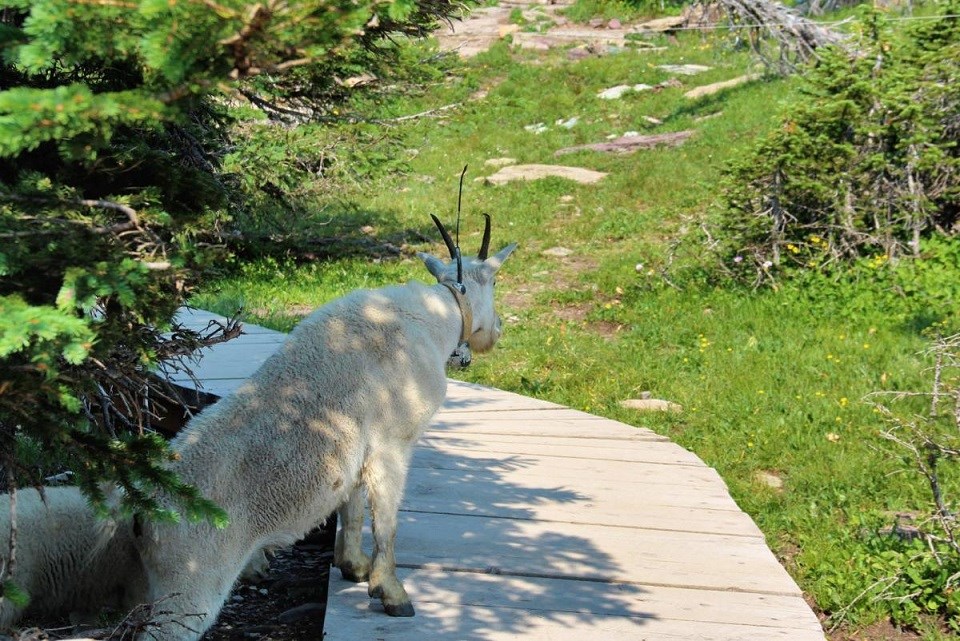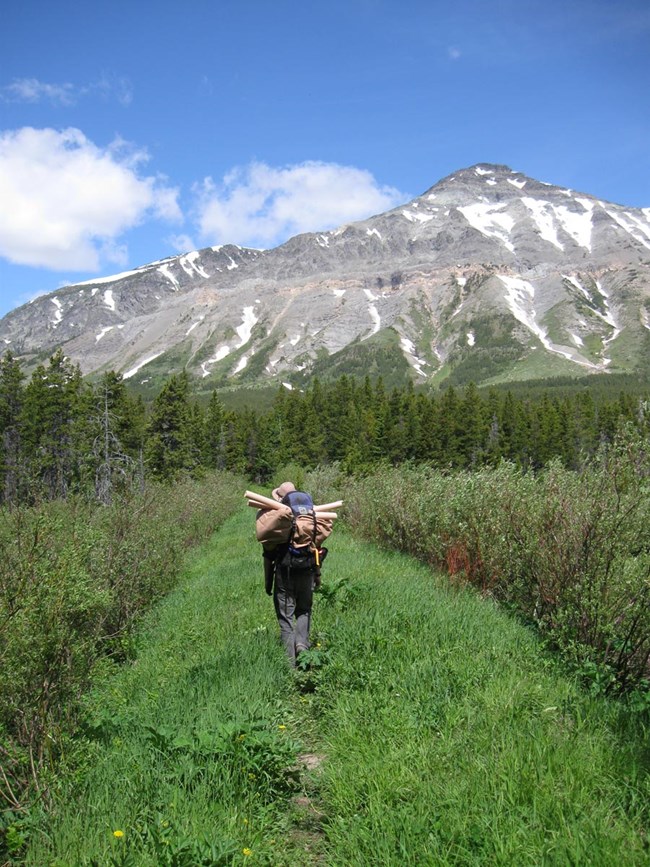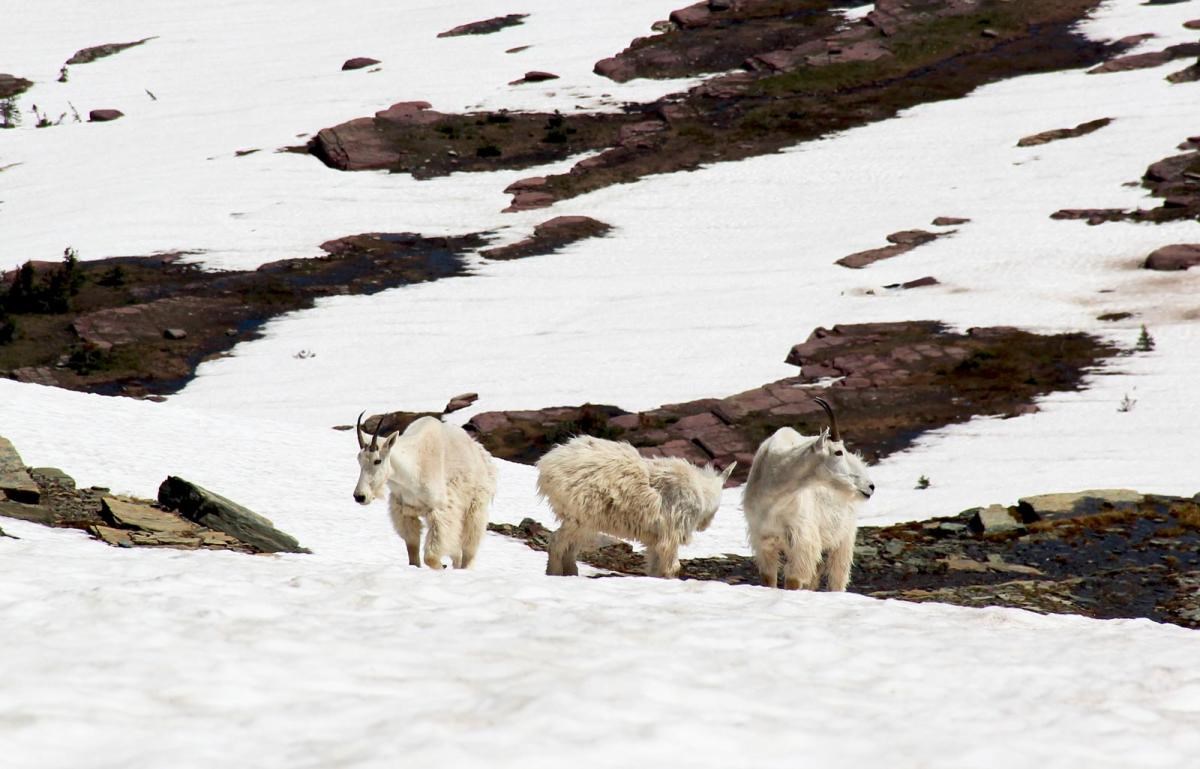By Colin May
Article
Unsure Footing - Glacier’s Habituated Mountain Goats

NPS
Snow mutes the mountain goat’s hooves as she moves through the small trees along the trail. Distracted by the view at Hidden Lake Overlook, I don’t notice her until she’s standing right in front of me. Her off-white wool still has patches of winter coat. Her sharp black horns curve off the top of her head. After observing me for a few moments, the goat turns and continues on her way.
I had been warned that the goats at Logan Pass possess little fear of humans and that close encounters are likely, but it still surprises me to find myself so near a wild animal. Until now, my experience viewing goats consisted of a pair of binoculars and small, white figures dotting the steep cliffs above Avalanche Lake. Here at Logan Pass, you don’t need binoculars.
Even compared to sweeping views of backbone ridges and monument peaks, a close interaction with a wild animal can be a visitor’s most powerful experience at Glacier National Park. Wesley Sarmento, a mountain goat researcher from the University of Montana and my guide at Logan Pass, echoes these sentiments.
“There are probably 50 people here,” Sarmento points out. “All crowded around watching one goat. I suspect it’s the highlight of a lot of people’s trips, getting to see these animals close up.”
But close access to mountain goats raises some issues. Visitor safety is a high priority, and many get far closer to goats than the park’s rule of 25 yards. Sarmento interrupts our interview several times to remind people to stay on the trail, and that goats, though cute, can be dangerous.
-
Stay on the Trail
Researcher Wesley Sarmento reminds visitors at Logan Pass not to get too close to the resident mountain goats.
We’re learning that human proximity causes problems for the goats, too; these goats at Logan Pass aren’t totally wild anymore. To investigate this issue, Sarmento is in the second year of a three-year study into how the mountain goats’ relationship to humans alters their behavior, a process known as habituation.
Figuring this out means asking the right questions: How and when are goats using areas with heavy visitor use? How and why might goats be aggressive to humans? To what extent are goats demonstrating “unnatural” behavior because of human influence? And how can we deter problem goats from problem behaviors?
Sarmento is the passionate workhorse of a project with many players and moving parts, including two full-time technicians who help gather data. The project is overseen by Glacier’s Natural Resources Program Manager, Mark Biel, and University of Montana Professor Joel Berger. Understanding these human-wildlife interactions is a fundamental objective of the park’s Going-to-the-Sun Road Corridor Management Plan. The plan outlines a comprehensive assessment of the human impact and use of the park’s most highly trafficked artery, the Going-to-the-Sun Road, and its surrounding areas.
Another goat steps onto the boardwalk at Hidden Lake Overlook. This one stands out—it’s wearing a collar of leather and plastic, with a conspicuous antenna. Having this piece of humanity attached to it may make the goat seem even less wild, but the collar is a crucial tool.
Biel, who heads up the complex operation of safely capturing and collaring the goats, hoped to equip a total of 25 goats with tracking devices. He and his crew came close to reaching that goal; 24 goats now have radio or GPS collars. The effort is worth it. Collars allow researchers to track the goats’ locations and maintain continuous data on individual goats. The GPS collars take the goats’ locations every two hours, generating thousands of data points for the study.
In studying how the goats make use of Logan Pass, Sarmento has formulated two hypotheses.
“The habituated goats time their movement into the overlook pretty well with people,” he explains. “It’s either because they know the people are going to be giving them salt, and that’s when they show up. Or they know that people are scaring away predators and it’s safe to come in.”
Salt is an important resource for mountain goats, and they are desperate to get it. Because goats don’t get salt from the vegetation they eat, their natural behavior is to venture to mineral deposits, or licks. To do this, they often leave the safety of the cliffs they cling to. These cliffs serve as their escape route from predators like bears, wolves, and mountain lions. Getting salt from a natural lick can be risky. At Logan Pass, a different salt source exists—human urine.
“Wild goats go in, get the salt, and get out of there” Sarmento explains. “They don’t want to spend an extra minute in those dangerous locations. The habituated goats come here, lick salt, sleep, feed, lick more salt…they’ll hang out all day. It seems they feel safer.”
Indeed, the goats at Logan Pass seem relaxed despite their distance from cliffs. They mosey around people at the Hidden Lake Overlook, stopping at trees to lick what was probably a visitor’s makeshift restroom. It’s a complex situation. Are they here because we provide salt, or safety, or both?
“With enough data,” Sarmento says, “we should be able to know for sure.”
As we start back down the trail, more visitors flood past us toward the goats, in awe of the iconic species. My awe, however, is muddied with uncertainty.
***

NPS
A few weeks before our trip to Logan Pass, Sarmento takes me into the backcountry to see a natural mineral lick. The goats that frequent this lick don’t see many humans, and so Sarmento refers to them as “wild” goats. He concedes that the goats at Logan pass are also wild, but because of habituation, they’re further from their natural lifestyle.
To get to the lick, we hike a few miles up a trail, then bushwhack toward the base of a mountain. When we arrive at a meadow a quarter mile from the lick, Sarmento pulls out his binoculars. He points to white dots on the mountainside—three groups of goats next to a wet patch leaking from beneath the cliffs.
In order to understand habituated goats, Sarmento needs to know how their behavior differs from goats with less exposure to humans. Perhaps the biggest differences are the ways they protect themselves. The “wild” goats visit licks in a group. They don’t bed down far from a cliff. They’re skittish around humans.
At this point, Sarmento goes into researcher mode. He gets out his clipboard, GPS, rangefinder, and stopwatch. We’ll be in this meadow for an hour while he performs a behavioral scan. Every three minutes, Sarmento marks what each goat is doing—is it bedded, feeding, licking, moving, or vigilant? He records other variables: distance to escape, grouping, and habitat type.
-
In the Field
Sarmento explains what types of behaviors he is documenting and how habituated goats act differently from "wild" goats.
Data collection seems monotonous, but it’s the lifeblood of a project like this. Sarmento has plenty of patience for it, and goes into the field almost every day to get more samples. He’ll spend all winter crunching the data.
After we finish the scan, Sarmento asks me to keep as quiet as possible as we continue our approach.
“The plan is to get in on these goats without scaring them,” Sarmento whispers. “We’re trying to control for a lot of things, and a human influence is one of them. These are wild goats here. They’ll run from people at 500 yards.”
As I creep through the trees to our next scan site, with a dozen mountain goats perched nearby, I can’t help but feel privileged to be in the presence of truly wild animals.
***

NPS
The sun beats down and a group of mountain goats move into the shade of a crooked mountain peak at Logan Pass. A beautiful scene for sure, but there’s something wrong. I hear a young girl ask her mom if she can pet a goat. I watch a grown man try to feed a goat a flower. This isn’t the wild place it’s supposed to be. It’s not supposed to feel like a zoo.
As we hike back down the trail, weaving in and out of incoming visitor traffic, we encounter another mountain goat licking at the ground in a small copse of trees. Among the huddled spectators, a young girl frowns in disgust when Sarmento explains that the goat is likely licking up human urine. I know how she feels.
It’s like we’ve diminished the mountain goat, in some way, to mere spectacle. In having their behavior so altered, they’ve lost some of their majesty. And it’s undeniable that we did this to the goats, though of course we didn’t mean to.
The question looms: how do we fix it? How do we find the balance between allowing visitors to enjoy these beautiful creatures and preserving the health and safety of both humans and animals?
“We have to understand habituation fully,” Sarmento says. “A lot of folks think it’s just salt. But what if we take away the salt and the goats are still here? And something else is going on? To make good management actions, you have to understand the problem.”
Despite their iconic status, mountain goats are relatively unstudied, so it will be a long road to complete understanding. Sarmento urges patience. We shouldn’t jump to conclusions, even if a hypothesis makes sense. “Let’s make sure that what makes sense is actually what’s going on,” he says. “Ecology has a funny way of proving us wrong.”
I continue down the trail, leaving the goats to themselves, and hope that others will follow. As our vision of the problem becomes clearer, we should feel inspired to act toward an enduring mission—to respect the wildness of wild animals.
-
Unsure Footing: Glacier's Habituated Mountain Goats
How are people affecting wildlife behavior in Glacier National Park? Millions of visitors travel the Going-to-the-Sun Road every year, changing behaviors of some wildlife species. This film highlights research on mountain goats at Logan Pass where researchers are looking at various factors to determine why these goats act differently than others throughout the park.
- Duration:
- 4 minutes, 50 seconds
Downloadable pdf
Last updated: December 5, 2017

